In: Post Soviet photography
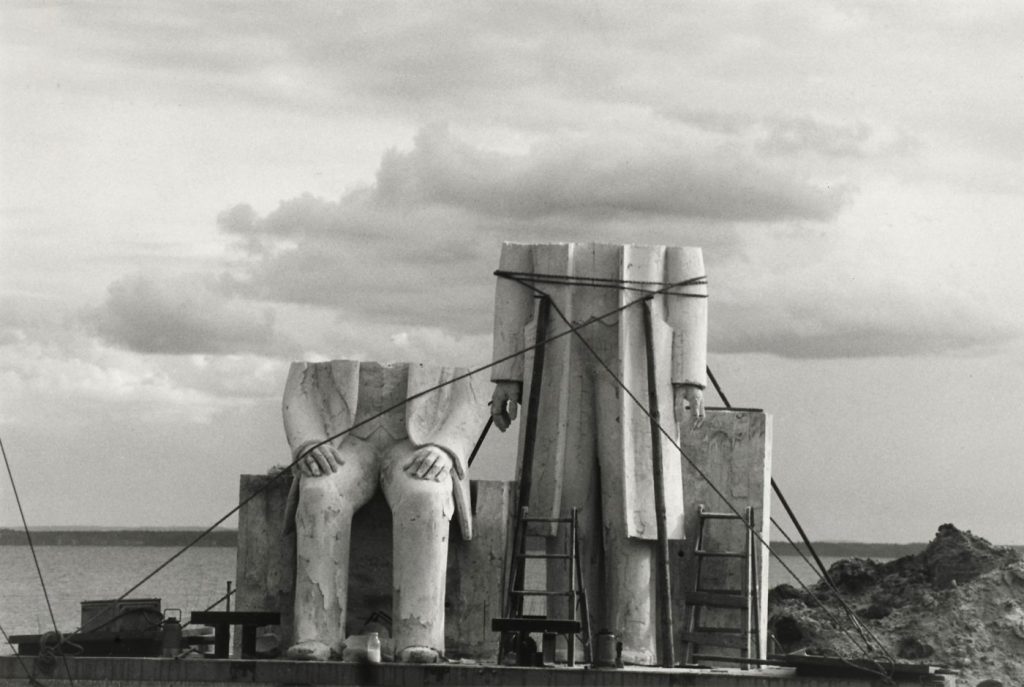
Sibylle Bergemann | The Monument | 1975 – 1986
November 6, 2023Sibylle Bergemann | The Monument | 1975 – 1986
Nothing seems more improbable than what people believed when this belief has gone with the wind. (Doris Lessing)
I am old enough to remember when the Berlin Wall fell and the end of the Cold War. In a fine inversion – and something that speaks to how history is often a collaborative delusion and how, at its best, art history can be the most direct and yet most subversive form of history – I would be teaching a decade or so later and have to explain to students what both of those events were, and why they still mattered. That was also a time when I reread Doris Lessing (I recommend her award winning – and divisive, to many readers and critics – book The Good Terrorist) : I had disdain for her books when I read them in my early twenties, and was surprised at how much more sense they made to me, as I had matured and gained experiences that resonated with her words, when I was older. At that time, I was able to appreciate her words – and especially the sentiment behind them – that I quote at the start of this essay a little better….
Critic Jane Rogers (in The Guardian) described The Good Terrorist as “witty and … angry at human stupidity and destructiveness.” I must inject (as one can’t look at these images by Sibylle Bergemann and not consider the contested legacy of Marx and Engels, communism and the GDR) how I like to antagonize my christian and communist friends (not the same people, to be clear) by citing Mordecai Richler from his seminal book Solomon Gursky Was Here. In the voice of the aforementioned Gurksy, Richler avers that the system (whether the Sermon on the Mount or the Communist Manifesto) is inspired but it is humanity that is vile…
Enough tangential commentary, let’s have some facts : “From 1975 until 1986 Sibylle Bergemann accompanied the making of the huge bronze of Marx and Engels in Gummlin / Usedom from the first sketches to the installation. The work, which was created by the sculptor Ludwig Engelhardt, is still located near the Alexanderplatz in Berlin-Mitte.” There has been controversy about this monument, as Germany struggles with its past as defined in the present, whether it be the theoretical space of Marxism or that the GDR was one of the most repressive states in the 20th century. Monuments, after all, occupy both physical space and conceptual ground in any national imaginary.
In tandem with this, I’d suggest watching the ‘tragicomedy’ film Goodbye, Lenin : “the story follows a family in East Germany (GDR); the mother is dedicated to the socialist cause and falls into a coma in October 1989, shortly before the November revolution. When she awakens eight months later in June 1990, her son attempts to protect her from a fatal shock by concealing the fall of the Berlin Wall and the collapse of communism in East Germany.” A majority of that film was shot where this sculpture is located, at the Marx – Engels Forum.
First as tragedy, then as farce, ahem, someone (okay, Engels, ahem) said….
Bergemann’s words about her art and aesthetic : “I am interested in the edges of the world, not the center. The incompatible is crucial material for me. When something isn’t right about faces or landscapes that doesn’t quite fit…”
As of this writing, I am also working on an Artist You Need To Know post about the Mexican photographer Lola Álvarez Bravo (1903 – 1993). Bravo’s words also apply to Bergemann’s Monument series : “If anything is useful about my photography, it will be the sense of being a chronicle of my country.”
But I don’t approach this without bias : my stance can be seen in the primary image I’ve chosen, where the figures are ‘missing’ their heads, like a reversal of Shelley’s Ozymandius, where only the legs remain of his forgotten ‘king’….
More about this project can be seen here and more of Bergemann’s photographs can be enjoyed here.
~ Bart Gazzola
Read More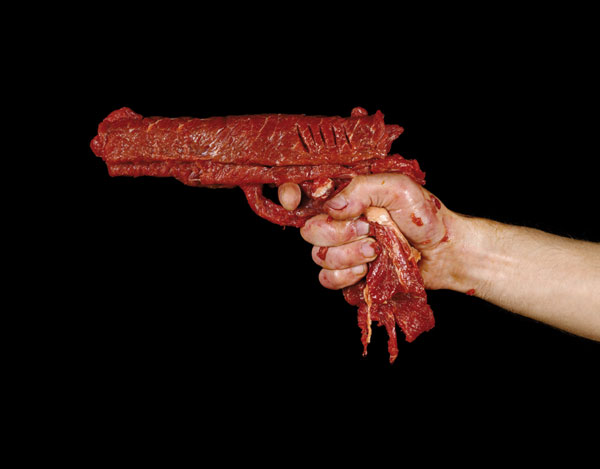
Dimitri Tsykalov | MEAT | 2007 – 2008
July 28, 2023Dimitri Tsykalov | MEAT | 2007 – 2008
It’s not a new idea that firearms make acts of violence ‘too easy’, almost ‘antiseptic’, as they minimize the necessary physical contact intrinsic to other acts of brutality. This is an idea that’s been raised about technology since we began using it to kill each other.
(At the risk of seeming flippant, I must also inject a quote that came to mind when I first encountered images of Tsykalov’s MEAT : Invariably, the first question asked about a new technology is, “Can this make killing less of a hassle?” The second being, “Can I have sex with it?”…)
The implicit ‘removal’ or ‘remoteness’ (I’m reminded of the ski pole scene from Timothy Findley’s The Wars, for example, where the firearm and act of murder almost seem separate from the character himself) makes it almost a ‘trivial’ or ‘throwaway’ action to fire a gun.
Dimitri Tsykalov’s MEAT works offer a counter to that, in a grotesque manner that is excessive : I’ve debated writing about Tsykalov’s ‘armaments’ for a while, unsure if they’re too flippant, or too horrifying, or a combination of both that is as unpalatable as gripping cold flesh while your hands are stained and overrun with effluvia…
These works don’t pretend to an aesthetic distance (like in Serrano’s work, or some other artists I’ve talked about here who – like myself, when I worked with fat, bone and meat for over two decades – are interested in creating inappropriately beautiful artwork) : I feel that Tsykalov takes pleasure in our revulsion and wants to evoke it from us, and considering what he’s ‘butchering’ the meat, flesh and bone into, this is not inappropriate. There’s a swagger here, a bravado that intends to make us ill. Meat and guns are, after all, metaphors for penises or toxic masculinity, and Tsykalov alludes to that (even with the titles that reference specific guns).
Tsykalov, in creating work that intersects with brutality and our capacity for it, as a species, has taken an opposing artistic path to someone like Ralph Ziman with The Ghosts Project (a past Curator’s Pick you can see here).
Tsykalov’s own words : “In these pictures I recognize the murderers within me, I recognize love and death within me; in these pictures I recognize my flesh as the cannon fodder it is and will be for the rest of my life. In contrast the secondary meat in these shots – the one that rots and that kills, the animal meat that is used to create the fleshy weapons – seems unscathed, sanguine and elegiac. It is incredibly alive, it is cannon flesh and we are already mortal.”
Dimitri Tsykalov was born in Moscow (1963) where he attended Polygraphic Institute of Moscow (1982-1988). He currently lives and works in Paris.
More of his work can be seen here.
~ Bart Gazzola
Read More
Nadav Kander | Chernobyl, Half Life, 2004
December 23, 2022Nadav Kander | Chernobyl, Half Life, 2004
I drink to our ruined house,
to the dolor of my life,
to our loneliness together;
and to you I raise my glass,
to lying lips that have betrayed us,
to dead-cold, pitiless eyes,
and to the hard realities:
that the world is brutal and coarse,
that God in fact has not saved us.
(Anna Akhmatova, I drink to our ruined house…, 1934)
I am old enough to remember when Chernobyl happened, and like many events it has become larger in the public consciousness as the years pass. In some ways, my time as a teenager had numerous events that have shaped history, as I also remember being in my high school history class and discussing the fall of the Berlin Wall, which happened a few years later.
One can’t speak of the fall of the Soviet empire without citing Chernobyl: Emmanuel LePage, in the graphic novel Springtime in Chernobyl (2012), asserts that ‘the disaster in Chernobyl is the first nail in the coffin of the Soviet Bloc.’ It is not unintentional, I think, that this metaphor is employed after an earlier passage where a widow describes the elaborate entombment of her husband’s irradiated body, like a pharaoh’s sarcophagus to hell instead of heaven…
It has become a touchstone for many artists in a variety of mediums. Some use this disaster as a means to a larger conversation. Others remind us of Stephen King’s Blind Wille reminiscing about his time in Vietnam (from Hearts in Atlantis), admitting it had much to “teach him, back in the years before it became a political joke and a crutch for hack filmwriters.”
In writing about his series Chernobyl, Half Life (2004), Nadav Kander offers the following:
“Reactor No.4 at Chernobyl’s Nuclear Power Station exploded in 1986 leaving the surrounding area uninhabitable for many hundreds of years to come. It happened to be the 20th Anniversary since the explosion when I gained access as an artist to visit Chernobyl, photographing the deserted spaces in what was once a model Soviet City.
Home to more than 40,000 people, the apartments, schools and hospitals that were hastily left following the controversial evacuation are stark reminders of past lives, leaving a disturbing sense of quiet. An uneasiness that I had never previously experienced.
There is a great beauty in a very real way to be found as the poignancy of human suffering almost hangs in the air. I found myself with a familiar feeling; best described as the feeling when walking through an overgrown cemetery on a drizzly day, but what I was looking at was far from familiar.
Having grown up with stories of relations of mine including my Father with his family that were suddenly evacuated during the second world war, I could not help but feel quite profoundly shocked as well and at the same time wonder what it must have felt like to suddenly leave your home and be transported to an unknown destination, suspecting that the near future would probably bring severe ill health due to being exposed to large doses of radiation. Little is known about the radio-active affects on the people of this city as the population were dispersed all over Russia. If there was a gathering of data by the government, it was never reported.”
I’ve selected a few of the images from this series, and most of them are focused upon spaces that would be set aside for children. Kindergarten Golden Key, Sleeping Room evokes a memory of visiting Spring Hurlbutt’s The Garden of Sleep / Le Jardin du Sommeil, which was also a contrasting beautiful space to meditate upon the death and loss of children, and both provide a focus for grief.
With work like this, there is a danger of the glorification of destruction: what one of my critical brethren has called ‘ruin porn.’ Kander, however, with his choice of sites has privileged the people – their absences are very clear, in the scenes he depicts – so that amidst all of the geo political discourse, humans and our humanity is not forgotten, willfully or otherwise….
Akhmatova’s words from half a century earlier act as a fine narration of these images: as an addendum to this pick, I’d also suggest the series Chernobyl, as it also focused upon the reality of Pripyat residents, situated within a larger historical narrative (much like Ahkamatova’s poems do).
And, with Russia’s ongoing invasion of Ukraine, some historians are reminding us of past events like the Holodomor – and in some ways, Chernobyl fits within this – where an ’empire’ exhibits cruelty and disregards humanity, whether through malevolence or ignorance, and sometimes I see Chernobyl through this lens, as well….
There is a surfeit of cultural commemoration or interpretation of this event and some is better than others. Kander’s work is quietly unsettling, even after all these decades.
More of this series can be seen here.
IG: @nadavkander
~ Bart Gazzola
Read More
Elena Chernyshova | Days of Night / Nights of Day, 2012-2013
December 8, 2022Elena Chernyshova | Days of Night / Nights of Day, 2012-2013
‘I was with my people then, there, where my people, unfortunately, were.’
(Anna Akhmatova, Requiem, 1935 – 1961, writing of her times in the soviet gulag)
When I lived in Saskatoon, an acquaintance who’d spent time in Eastern Europe once commented that that city in winter was like Siberia, but without the cachet of being that place (which exists as much in our imaginations as it does in reality, one might say – as a ‘great part of the imagination of the world is attached to that site’), nor with architecture that was anything but a failed brutalism (this was during a period with the ‘economic boom’ in Saskatoon where a number of heritage buildings were lost and the banal taupe of others rose like mottled angular tumours….)
Elena Chernyshova’s work is aesthetically stunning: not just for the evocative quality of the images, but also for the scenes they present to us, that seem to blend exotica and danger, a chronicle of sites that remind us of the irrelevance of humanity in the face of nature.
But her notes and comments bring the human element back, as this is not just a ‘pretty’ image, but a site of – of course – contested narratives, that looks back to the history of the USSR and some of the ideas of industrialization and ‘progress’ that have human costs.
Chernyshova’s own words are a powerful adjunct to her lens: “Days of Night / Nights of Day is about the daily life of the inhabitants of Norilsk. Norilsk is a mining city, with a population of more than 170,000. It is the northernmost city (100,000+ people) in the world. The average temperature is -10° C and reaches lows of -55° C in the winter. For two months of the year, the city is plunged into polar night when there are zero hours of sunlight.
The entire city, its mines and its metallurgical factories were constructed by prisoners of the nearby gulag, Norillag, in the 1920s and 30s. 60% of the present population is involved with the city’s industrial processes: mining, smelting, metallurgy and so on. The city sits on the world’s largest deposit of nickel-copper-palladium. Nearly half of the world’s palladium is mined in Norilsk. Accordingly, Norilsk is the 7th most polluted city in the world.
This documentary project aims to investigate human adaptation to extreme climate, environmental disaster and isolation. The living conditions of the people of Norilsk are unique, making them an incomparable subject for such a study.”
Chernyshova offers the following about the image of monumental architecture (with a blue suffusing light): The construction plan of Norilsk was established in 1940, by architects imprisoned in the nearby Gulag. The idea was to create an ideal city. The most “ancient” buildings are constructed in the Stalinist style. The next step of construction happened in the 60s, when the prevailing method in the USSR was to use pre-built panels.
Her other writings also allude to the disputed, if not adversarial, stories that meet and intersect in Days of Night / Nights of Day. The scene with the car and hazy clouds the colour of sulfur has the following notation: In the summer, there is a period when the sun doesn’t go under the horizon. This continues from the end of May till the end of July. It is accompanied by good weather and pleasant temperatures. Around 3 am, while the city sleeps, it is still illuminated by the sun. The city seems like a ghost town, emptied of its inhabitants.
One of the images I’ve included from Chernyshova’s series is unlike the others: and its difference helps to offer insight into the whole. Again, Chernyshova’s voice must be borrowed: Anna Vasilievna Bigus, 88, [who] spent ten years of her youth in the Gulag. At age 19, she was separated from her family and sent into the Arctic Circle. “The only joy we could have in Gulag was singing. We sang a lot. And this gave us the strength to survive…” Her daughter became a music teacher and her grandchildren sing in opera.
The complete series (produced with the support of The Jean-Luc Lagardère Foundation) can be seen here and a feature from LensCulture (where Chernyshova offers some words about many of the images I’ve shared here, that offer more nuance and depth to her vision) can be enjoyed here.
Elena Chernyshova’s site
@elena.chernyshova.photography
~ Bart Gazzola
Read More
Around the Red | Viktor Balaguar
April 14, 2022Around the Red | Viktor Balaguar
Balaguer’s series Around the Red (which includes the image shared here) is perhaps my favourite of his series (a hard decision, though, as Teriberka or Street Photography for Xiaomi are enchanting, too).
Often, his images of St. Petersburg and Moscow suggest a perpetual winter in Russia, but these are less so of that style. The vibrant reds – which never seem forced and hold your eye without overly dominating the scene – run through these works, which are captured moments of places and people. The title implicates historical factors, of course, as Russia and the world are still negotiating the rise and fall of the USSR, in contemporary Russia and beyond those borders (sometimes acknowledging what happened, sometimes not, as we dance ‘around the red’). There is no point when ‘then’ stops and ‘now’ begins in sites of contested narratives (like St. Petersburg or Moscow, Eastern Europe or even in a larger world history), and Balaguer’s Around the Red sometimes hints – and sometimes hammers – at that, visually.
I should add that I began writing this post prior to the most recent acts of war by Russia, but that simply adds more weight to the geo – political insinuations of Balaguer’s scenes….perhaps, as Aleksandr Solzhenitsyn warned us in his The Gulag Archipelago if you “dwell on the past…you’ll lose an eye. Forget the past and you’ll lose both eyes.” To be honest, I had mixed feelings about sharing this work, considering the current political climate, but will temper that with the recommendation of Timothy Snyder’s book Bloodlands: Europe Between Hitler and Stalin, from 2010…..
From here : French photographer, architect and interior designer Viktor Balaguer fell in love at first sight with the ‘Venice of the North’ where he has settled with his family. “Saint Petersburg is a romantic city where you can go from a narrow street to wide avenues, where you follow the sublime and immense Neva River that is completely frozen for part of the year,” he said, calling it “A city of strong contrasts, with a succession of magical palaces and imperial facades whose entrance gates you must cross and visit the dark backyards of the Soviet era. A city deeply melancholic by nature, immersed in a relaxing rhythm of life and permanently open to contemplation.”
In selecting this image, I had a difficult time, as any of the vignettes in Around the Red by Balaguer are worthy of consideration: you can see more of them here, and many of his other fine images at both his IG: @viktor_balaguer and his site.
~ Bart Gazzola
Read More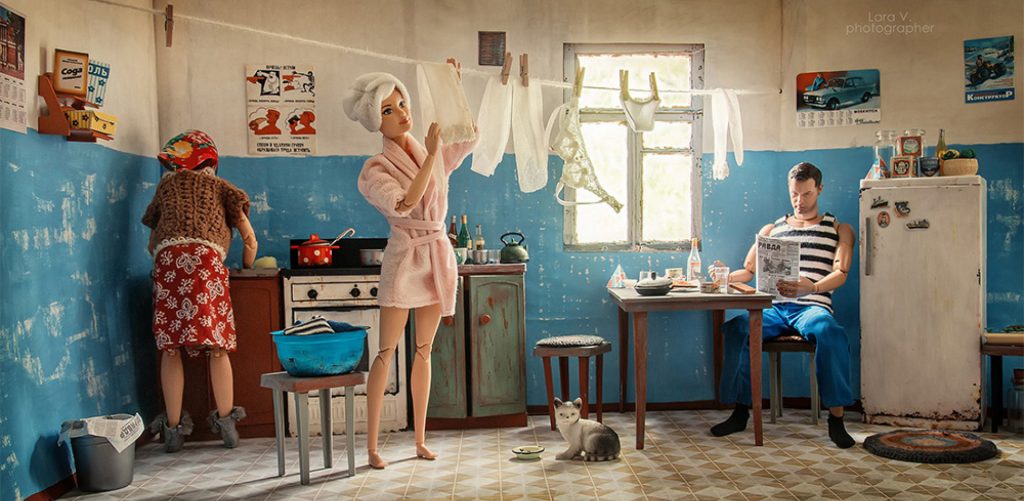
Lara Vychuzhanina | The life of Barbie and Ken in the Soviet Union
November 30, 2021Lara Vychuzhanina | The life of Barbie and Ken in the Soviet Union, 2017
First as tragedy, then as farce, we were warned a long time ago by Marx, is how history will play out. That’s a bit damning, but as we make our way further into the 21st century, it’s to be forgiven if many of us also see a more black than bleak humour in all this, a dark comedy that still makes us laugh, inappropriately.
Lara Vychuzhanina (whose Instagram name is aptly @lara_art_dolls) is a Russian photographer from Yekaterinburg – formerly known as Sverdlovsk, during the Soviet era, which I mention as it intersects with some of the ideas present in her work here, where she’s created a tableaux of Barbie and her partner Ken living in the USSR in the 1980s.
There’s always an element of nostalgia in depictions of history, allusions to a ‘simpler time’, and it’s interesting to see one about the USSR, as in the West we’re usually inundated with this false trope about the 1950s, or 1960s: Lara Vychuzhanina is too young to remember the 1980s in the former Soviet Union, but this doesn’t stop others from offering caustic and contested interpretations of those eras, either. Employing Barbie and Ken for this is a nice intersection of mythologies of East and West, capitalism and communism, plasticity and reality – and it is also, in the inherent contradictions of its assemblage, very funny.
After all, “comedy is in act superior to tragedy and humourous reasoning superior to grandiloquent reasoning” (which, fittingly, is attributed to Friedrich Engels by Karl Marx, back in 1862)…..
More images by this artist can be enjoyed at her Instagram. ~ Bart Gazzola
Read More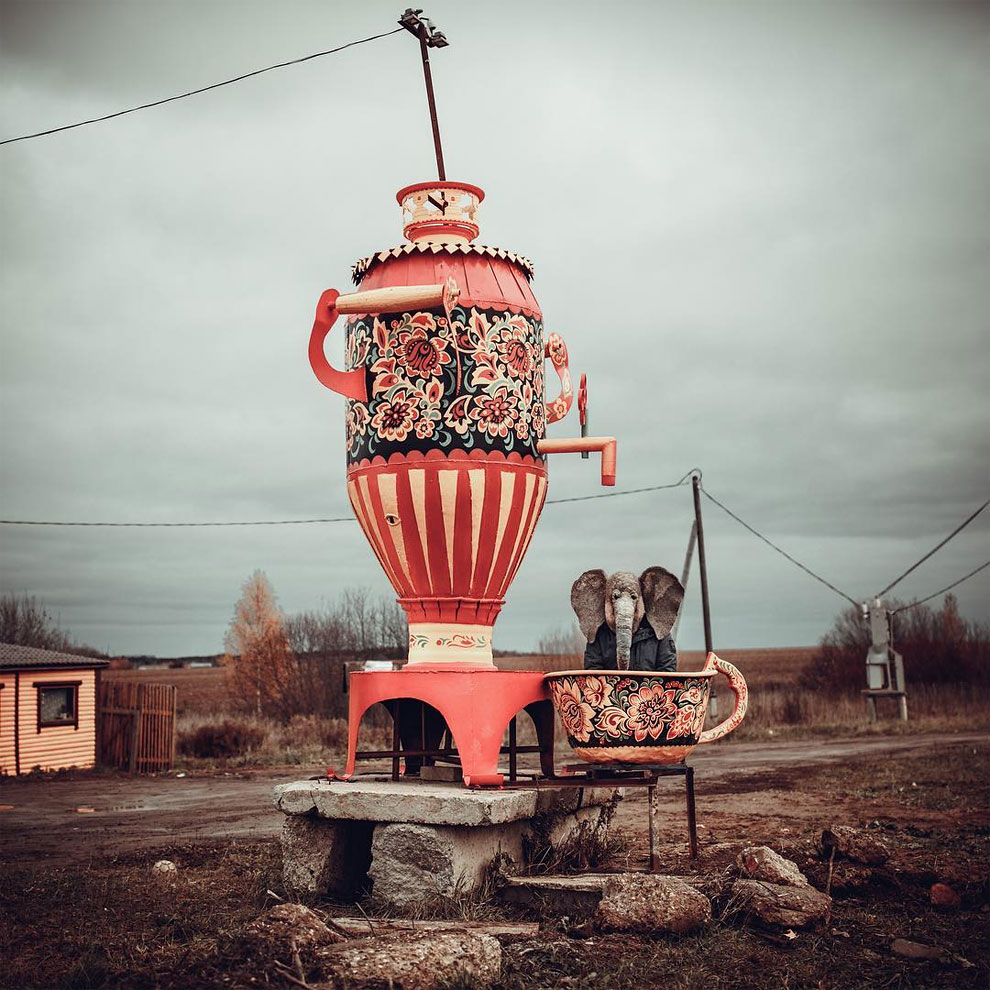
trunkdrunk
July 31, 2021Perhaps you’re familiar with the story of Pagliacci, the clown consumed by sadness he hides to make the audiences laugh. I will admit it will always be tied, for me, with Alan Moore’s Watchmen. In that graphic novel, Rorschach offers something of a lonely graveside eulogy for the character The Comedian (who ‘evolves’ from a snide position of ‘Once you realize what a joke everything is, being the Comedian is the only thing that makes sense’ to a weeping lament of “I mean, what’s so funny? What’s so goddamned funny?”). Rorshach recites a ‘joke’ about Pagliacci’s visit to a doctor, decrying his despair, only to be told by the well meaning doctor to visit the ‘famous clown’ to be cheered up. Pagliacci bursts into tears, revealing to the well meaning but unaware doctor that he is, in fact, the clown, and an empty shell who can’t even help himself…
The self described ‘comedian’ trunkdrunk occupies that same space. His Instagram page offers only that “I don’t even ask for happiness, just a little less pain.” An article on his work has the following spare and succinct comment: “trunkdrunk takes photos in Russia’s saddest places. As this was not sad enough, he takes pictures in full head overhead elephant mask. Images are captured in different places of Russia; mostly in gloomy and depressing surroundings.”
More of trunkdrunk’s images can be found on Instagram often accompanied by long swathes of text in Russian, that meld dourness, humour and memory. This image was originally posted to his IG account in October, 2016, with the following reminiscence: “Indian tea, the same – with an elephant. I remember him from my Soviet childhood. when my mother poured this Indo-Georgian mixture into a glass from a cardboard box, and then poured boiling water – the smell was stunning throughout the apartment!”
A previous Curator’s Pick of mine was a wonderful image by Alexey Titarenko: this could be said to have documented the fall of the Soviet Empire, in real time, with very real people as the unwilling players. Looking at trunkdrunk’s world, nearly forty years later, offers a new chapter to Russia history, perhaps attempting to laugh as one has no other choice, except to cry. ~ Bart Gazzola
Read More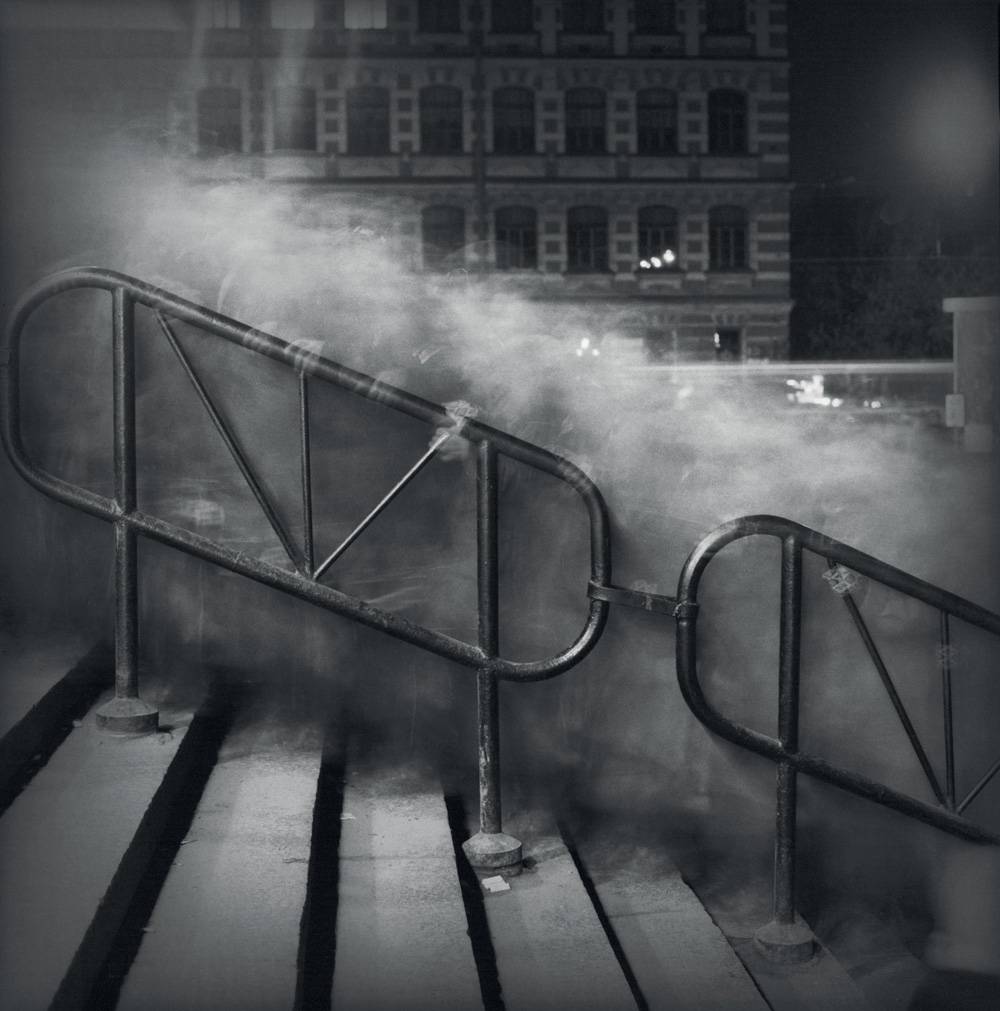
Metro Station Crowd 1, City of Shadows, 1992
April 20, 2021Alexey Titarenko, Vasileostrovoskaya Metro Station Crowd 1, from City of Shadows, 1992
I was twenty two when Titarenko captured this image, a freshly posthumous portrait of the USSR – and that was nearly forty years ago. The Cold War, as we knew it, was over, but the uncertainty, both for the bustling passengers of the once and future St. Petersburg, after its decades as Leningrad, and the rest of the world, is encapsulated in this image. Titarenko is an acclaimed photographer, not least for how after “the collapse of the Soviet Union in 1991 he produced several series of photographs about the human condition of the Russian people during this time and the suffering they endured throughout the twentieth century. To illustrate links between the present and the past, he created powerful metaphors by introducing long exposure and intentional camera movement into street photography. The most well known series of this period is City of Shadows.” More of Titarenko’s work can be seen here.
~ Bart Gazzola
Read More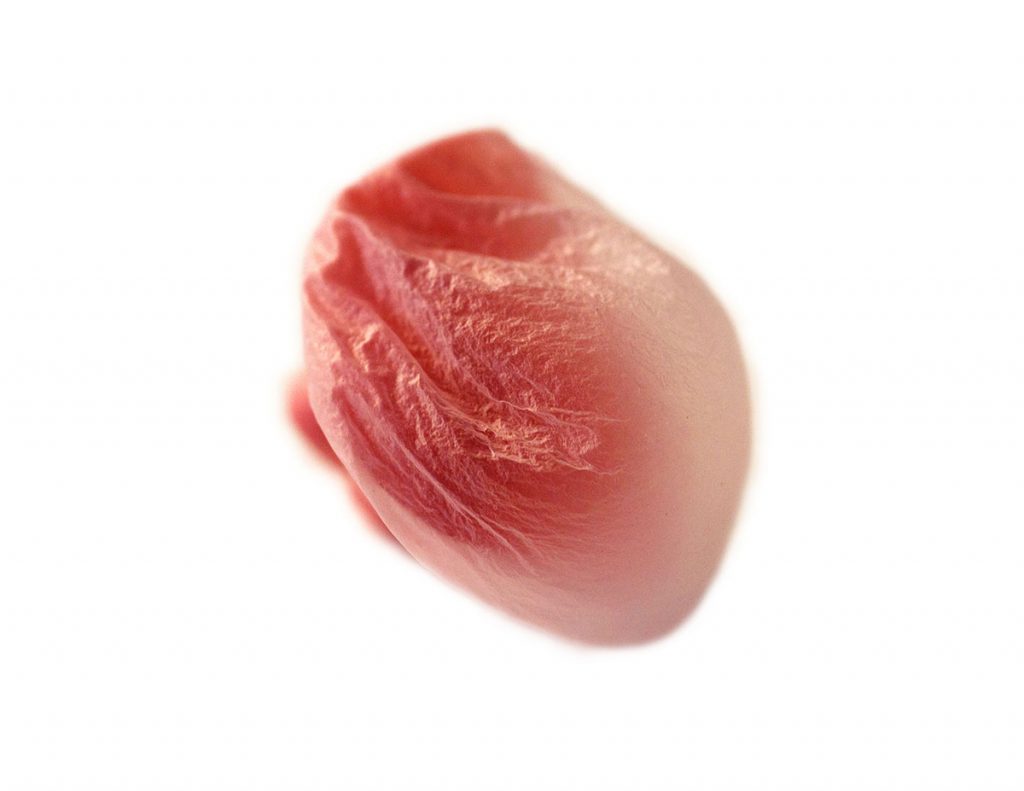
Amber Lee WIlliams – Femina Bulla Est #9
August 18, 2021The work of Amber Lee Williams, an artist from the Niagara Region of Southern Ontario, almost always concerns itself with motherhood and children, exploring the concepts of life within, the constancy of change, attachment and removal, and notions of femininity.
Femina Bulla Est (Woman is a Bubble), is a sequence of macro photographs of pink bubblegum. Amber deftly takes the binary state of man’s being, as depicted by the soap bubble in Dutch Renaissance Vanitas paintings (homo bulla est) and turns it on its ear… where man is either strong or broken, women have a strength and flexibility that allows them to persevere.
“I thought I would begin by simply blowing soap bubbles, photographing them, and seeing what happened. I asked (my daughter) if she wanted to help me blow bubbles and she thought I meant bubblegum bubbles. As soon as she mentioned the bubblegum it was a total lightbulb moment, and I have to give her credit for the idea.”
Femina Bulla Est #9 is incredibly organic, suggesting a beating heart, or the crepe-like tissue of placenta. Partially inflated, one gathers that there is life within, flush with blood and good health. One could also perceive the darker top section as a scab, protecting the soft tissue below as it heals from a trauma.
“The original bubble in Vanitas paintings suddenly pops and life ends, but in my version the bubble inflates and deflates again and again. The bubble is both fragile and resilient. Beyond the more obvious, and my personal connections to motherhood (carrying a child within my body, that body stretching…), I also think of the inflated and deflated, not just as physical states but also states of mind and related to mental health.”
You can seem more of Amber’s work at https://amberleeart.com, and on Instagram @amberlee.art. ~ Mark Walton
Read More
Recent Comments